
The Paper learned that "One Wind and Lotus Lifting - Lotus Culture and Hangzhou West Lake" hosted by the Zhejiang Provincial Museum opened on July 8 at the West Lake Art Museum. The exhibition displays 170 pieces/groups of lotus-themed cultural relics and handicrafts from the Neolithic period to modern times, from the six-dynasty chicken head pot, Yue kiln celadon, Song and Yuan Longquan kiln lotus pattern celadon, to Chen Hongshou's "Lotus Double Butterfly Scroll", all of which reveal the lotus. The charm and elegance of the themed artifacts.
Jiangnan Ke Cailian Lotus Leaf He Tiantian
The large-scale planting of lotus in the West Lake of Hangzhou can be traced back to the Wei, Jin, Southern and Northern Dynasties. During the Eastern Han Dynasty, Buddhism was introduced to China from India, and by the time of the Wei, Jin and Southern and Northern Dynasties, it had spread to the north and south of the river. The prevalence of Buddhism has promoted the rise of Buddhist art. The lotus flower is located in the mud but not stained, and the flowers, fruits and seeds coexist, which is quite Buddha. It is also the national flower of India, where Buddhism was founded, and has become a symbol of Buddhism. Many ritual objects are related to lotus. The lotus flower was heavily decorated on the utensils of the Six Dynasties, which not only conforms to the fashion of the time, but also has considerable aesthetic value.

Southern Dynasty Yue kiln celadon pot with dragon handle and chicken head with lotus petal pattern in the collection of Zhejiang Provincial Museum
The chicken head pot is a typical celadon vessel of the Six Dynasties. The nobles of the Southern Dynasty advocated "showing the bones and clearing the image". The chicken-head pots of this period also showed a slender shape and a towering chicken head.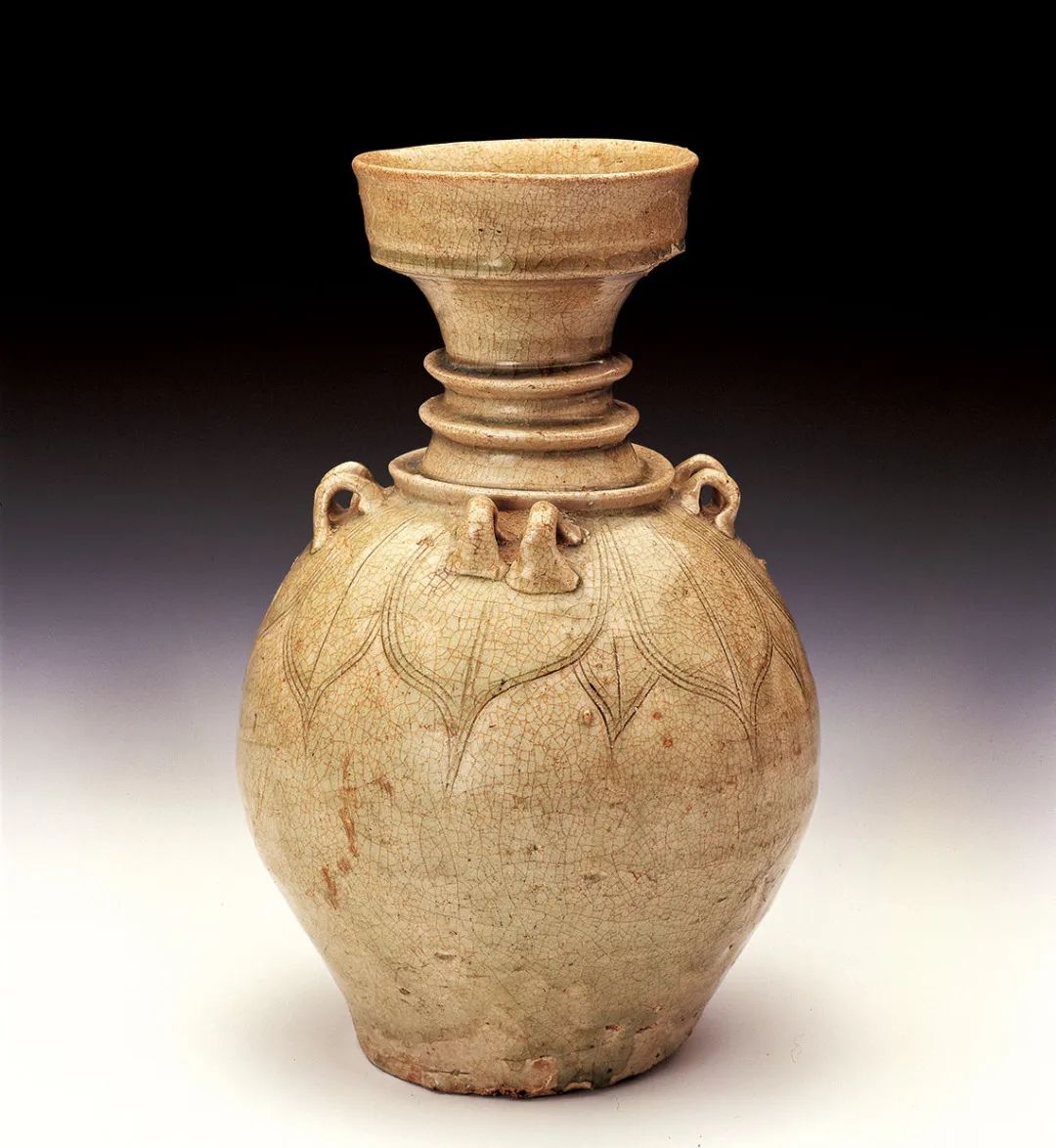
Southern Dynasties Ou Kiln Celadon Poppy with Lotus Petal Pattern Unearthed from Guimen Mountain, Yunjiang Community, Ruian, Zhejiang in 1964, Collection of Zhejiang Provincial Museum
Poppy, commonly known as "pankou pot", was a popular vessel style after the Han Dynasty. Buddhism was introduced into China at the end of the Western Han Dynasty. After the spread of the Han, Wei and Jin Dynasties, it was vigorously spread in the Southern and Northern Dynasties, and Buddhist art was also integrated into social life. The lotus flower in Buddhism is compatible with the Buddhist principles. People appreciate the lotus flower and yearn for the state of indomitable peace declared by Buddhism. The lotus petal pattern was popular at this time.
Southern Dynasty Yue Kiln Celadon Bowl with Lotus Petal Pattern Collection of Zhejiang Provincial Museum

Southern Dynasties Yue Kiln Celadon Plate with Lotus Pattern Collection of Zhejiang Provincial Museum
From the Han Dynasty to the Northern and Southern Dynasties, the style of drinking tea gradually became popular in the south of the Yangtze River. During the Eastern Jin and Southern Dynasties, special tea utensils were differentiated from eating utensils, and trays dedicated to drinking tea appeared. The center of the inner bottom of the tray is concave, and there are raised support rings around it. The lotus pattern on the tea set coincides with the prevalence of Buddhism. Celadon cups and plates with lotus patterns in the Southern Dynasties can be used as representatives of early tea sets.Thirty miles around the lotus flower, a thousand pine trees in Fucheng
During the Tang and Five Dynasties, the lotus landscape has become an important garden landscape in Hangzhou. There is a view of "circling the lotus flowers for 30 miles around the city and a thousand pine trees in the city". Qian Liu, the King of Wuyue in the Five Dynasties, established his country in the southeast, worshipped Buddha and built a temple, and Hangzhou was spread far and wide in China under the name of "Southeast Buddhist Country". In Buddhist teachings, the lotus flower is the sacred flower of Buddhism, a symbol of life and light, and implies pure merit and cool wisdom. In Buddhist classics, Zen koans, lotus and lotus figures are common. The prevalence of Buddhism and the large-scale planting of lotus flowers formed a synergy, and ultimately promoted the further development of lotus culture. In addition to Buddhist art statues, lotus decorations are also common in architecture, painting, bronze mirrors, stone carvings and other craft forms.
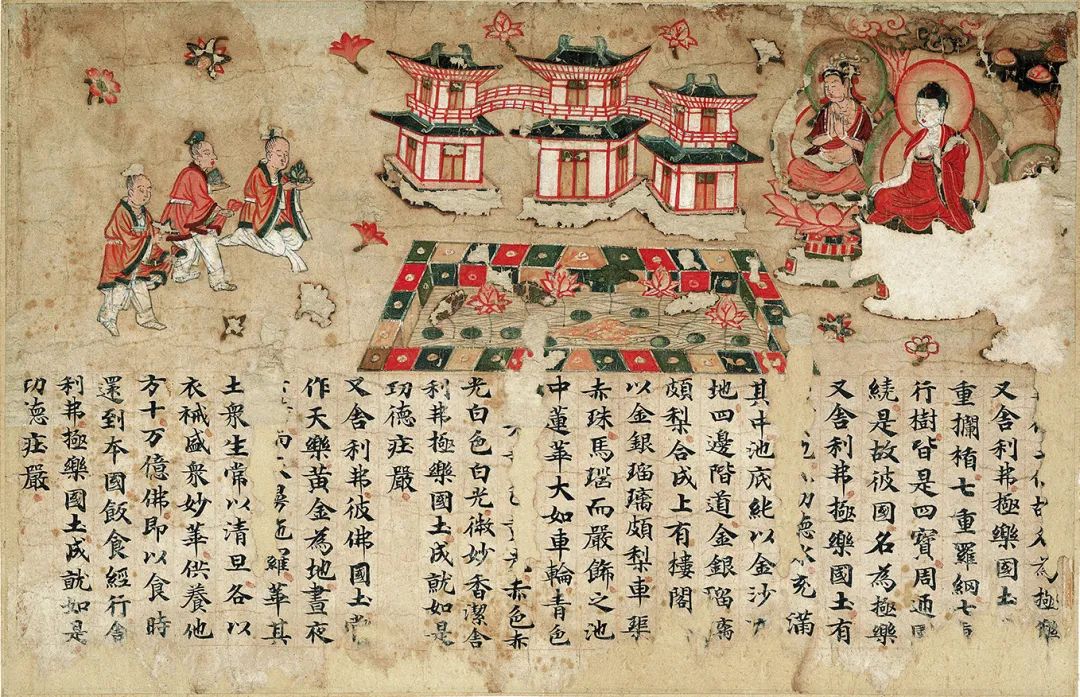
Tang "Buddha's Amitabha Sutra" in disguised form Unearthed from Huayan Pagoda in Jinsha Temple, Longquan, Zhejiang in 1956, collected by Zhejiang Provincial Museum
Script, scroll. The remnants of the scriptures are divided into two parts: the lower part is a passage of scriptures in the "Buddha Said Amitabha Sutra", and the upper part is a painted disguised picture based on the scriptures. In the picture, there are three donors on the left, Amitabha Buddha, Avalokitesvara Bodhisattva, and Dashizhi Bodhisattva on the right, and the heavenly flowers and auspicious clouds are scattered in the void. In the center of the picture is a pavilion of the Heavenly Palace, and there is a pool of seven treasures in the lord of the pavilion, with four lotus flowers in it. According to the "Buddha's Amitabha Sutra", "The lotus flower in the pond is as big as a wheel, with cyan light, yellow light, red light, white light, delicate fragrance and pure."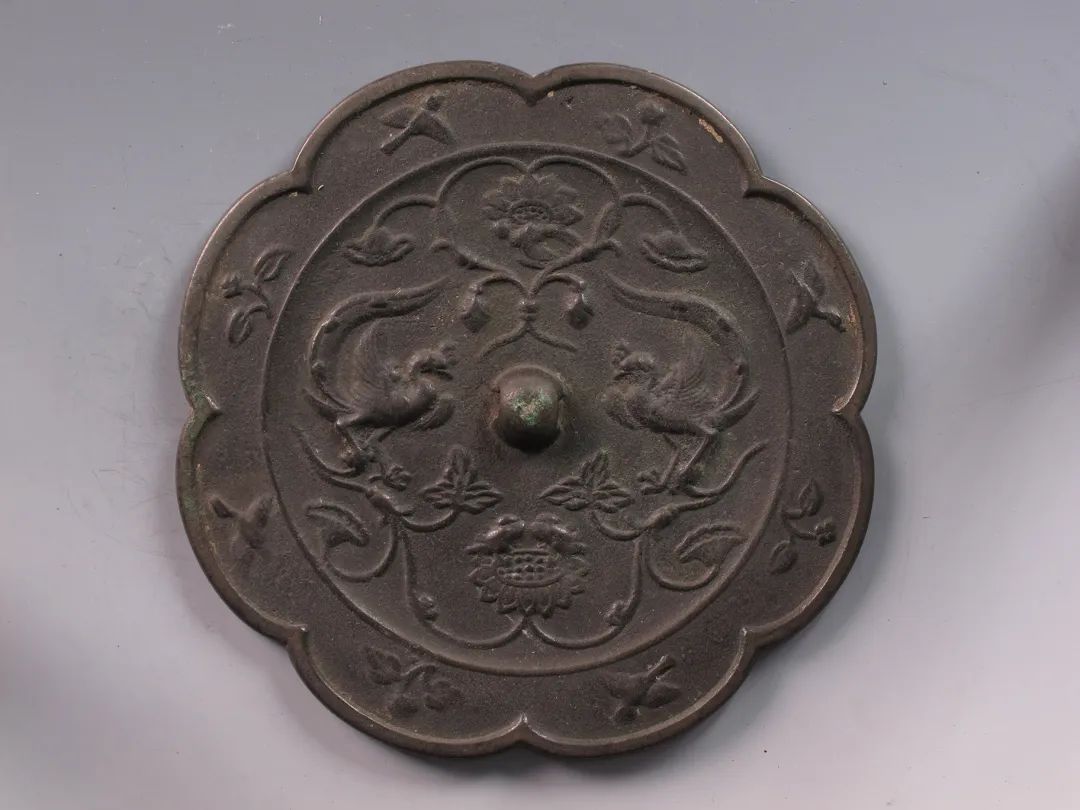
Tang Lotus and Bird Pattern Bronze Mirror Collection of Zhejiang Provincial Museum
The mirror is in the shape of eight sunflowers, with round buttons, double luan clip buttons facing each other, and flower branches on the foot. There is a lotus on the button, and a bird pecks the lotus seeds. There is a lotus flower under the button, and a pair of mandarin ducks are decorated on the lotus pod. The mirror edge is surrounded by four flowers and four birds.
Tang Yue kiln celadon lotus leaf cup unearthed in 1975 from the tomb of the second year of Tang Dazhong at the Heyi Road site in Ningbo, Zhejiang, in the collection of Ningbo Museum
The cup is composed of a tea cup and a cup holder. The shape is like a blooming lotus flower, the cup holder imitates the lotus leaf shape, and the edge is rolled up in quarters, forming a dynamic feeling of wind blowing leaves; The border effect of each petal. The center of the cup holder is concave, and the tea cup is attached to it, which is integrated, like a lotus leaf carrying a lotus flower in the water. The supporting light has no pattern, the glaze is green and lustrous like jade, the glaze is bright and clean, the shape is ingenious, and the production is exquisite.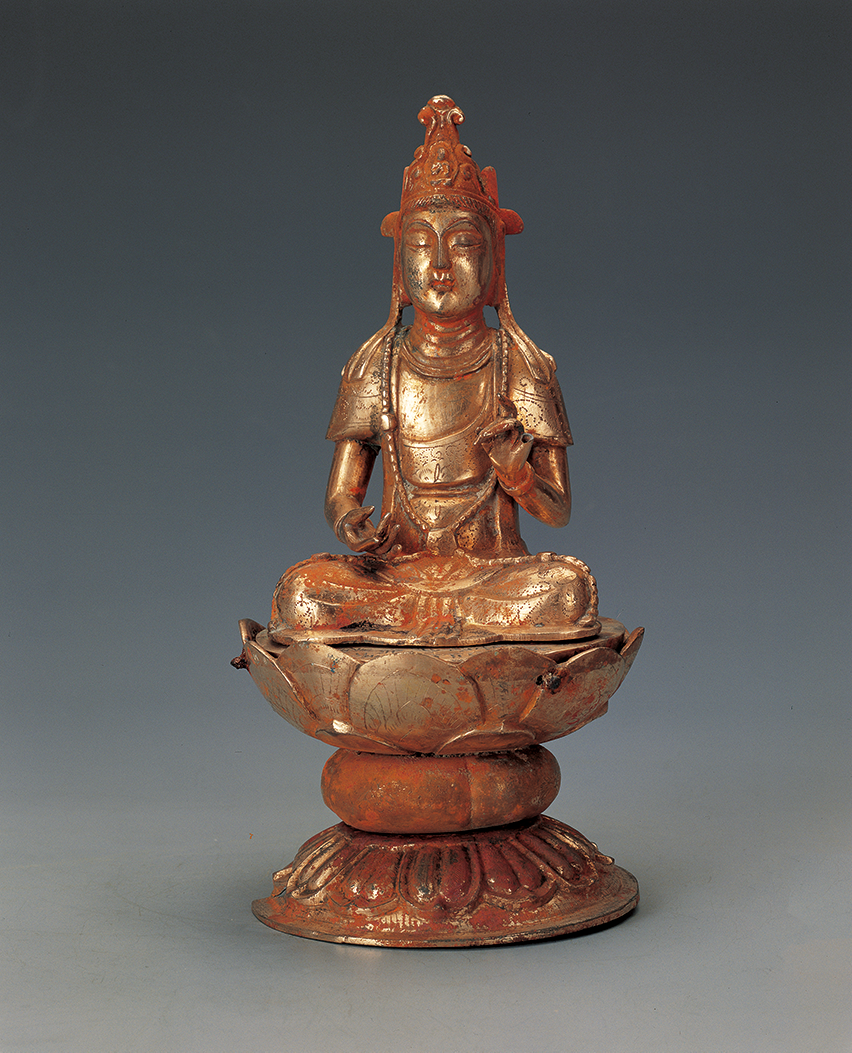
The bronze statue of Guanyin of the Wuyue Kingdom of the Five Dynasties, unearthed from the underground palace of the Wanfo Pagoda in Jinhua, Zhejiang in 1957, collected by the Zhejiang Provincial Museum
Guanyin wears a corolla on his head, decorated with a Buddha, a high bun, and an oblong face. He wears a collar on his neck, a pendant on his chest, and wears a celestial robe with a skirt on his lower body. The left arm is bent at the elbow, the right hand is placed on the knee, and Jijia sits on the lotus seat with the waist and overturned. The lotus petals of Yanglian are wide and full, very realistic. The waist is decorated with spherical ornaments, and the lotus petals of the covered lotus are in the form of treasures. An inscription is engraved on the lotus seat: "Disciple Xu Renyue and Wu Chongzhu jointly made offerings to Yongchong" .
Five Dynasties Yue kiln celadon jar with mandarin duck pattern and lotus leaf lid, collected by Zhejiang Provincial Museum
The Five Dynasties Yue kiln celadon reached its peak due to the promotion of Wu Yue Kingdom. Not only the body is beautiful and the glaze is clean, but the shape and decoration are also ingenious. The lid of this jar is a bionic lotus leaf, and the abdomen is a lotus pond mandarin duck carved with thin lines, which is vivid and full of vitality.The lotus leaves in the sky are infinitely green, and the lotus flowers are different red in the sun
During the Northern Song Dynasty, lotus flowers were widely distributed in the West Lake, with the beauty of "three autumn osmanthus, ten miles of lotus" . During the Southern Song Dynasty, the lotus landscape became an important garden landscape for the court and houses, and appreciation of the lotus became a trend. Yang Wanli wrote , "The West Lake used to belong to the savage family, but today it belongs to the family of heaven, not to him. There are willows in front of the Shuiyue Pavilion, and lotus flowers under the Jifang Garden." Zhou Dunyi, a great scholar in the Song Dynasty, closely combined the image of the lotus with the cultivation of the literati with his famous piece "Love Lotus", and the lotus became the flower of the gentleman and the "competition" of the literati. Under the leadership of the literati's interest, the elegant play of the study, the furniture display, and the fragrance of tea and wine are all associated with the lotus flower.
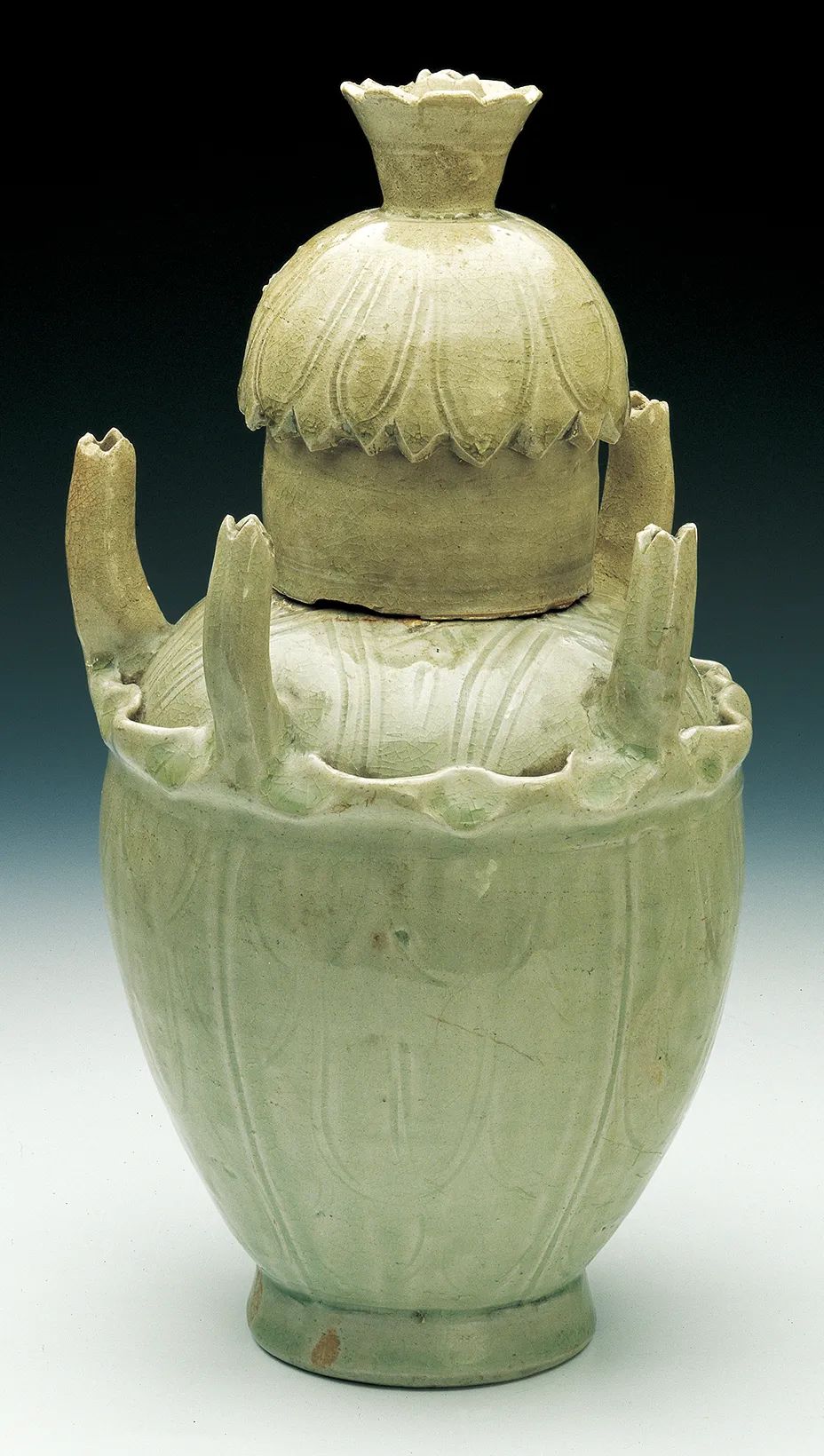
Northern Song Longquan kiln celadon lotus-petal pattern five-tube cap vase in the collection of Zhejiang Provincial Museum
Five-tube bottle, also known as multi-tube bottle and five-end pot, is named after the vertical polygonal or circular tubes distributed on all sides of the bottle shoulder. This bottle with a bionic shape, the lid is carved into a bud-covered lotus flower, the shoulder is carved with a lotus pattern on the back, the shoulder and abdomen are piled with wavy patterns, and there are five lotus stem-shaped flower mouth tubes in between, and the abdomen is carved With multiple lotus petals, the shape is dignified and beautiful. It is the representative work of Longquan kiln in the early Northern Song Dynasty.
Northern Song Dynasty Longquan Kiln Celadon Vase with Lotus Petal Pattern Collection of Zhejiang Provincial Museum
The texture of the bottle cap is delicate, the glaze is elegant, the double-petaled upside-down lotus pattern and the design of the lotus leaf-shaped lid complement each other and are vivid and vivid, representing the superb level of Longquan celadon in the design of bionic utensils at the end of the Five Dynasties and the beginning of the Northern Song Dynasty.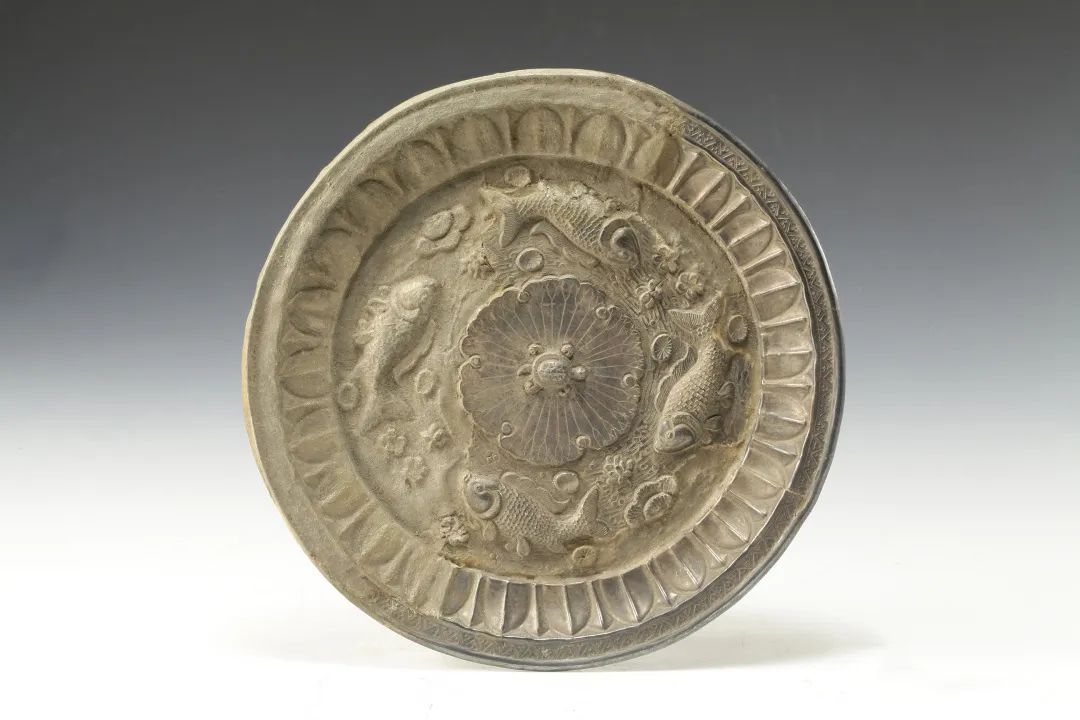
Southern Song Dynasty silver plate with fish and algae pattern, unearthed from the Song Dynasty cellar in Xiaopingqiao Village, Pingqiao Township, Liyang, Jiangsu in 1982 and collected by Zhenjiang Museum
Round platter, folded rim, flat bottom. A triangular pattern is engraved along the upper chisel, the belly wall is decorated with lotus petal patterns, and the bottom chisel pattern is lifelike. There is a huge lotus leaf floating in the center of the lotus pond. Chase and play in the lotus pond, just like the grand scene of the lotus pond in summer.Fish and algae pattern is one of the favorite themes of the literati and doctors in the Song Dynasty, and it appears widely in paintings, ceramics, gold and silver wares and other products. In the poem "Sheng Chazi" by Hongshi of the Southern Song Dynasty, entitled "Yao's mother's birthday banquet, drinking wine with a turtle swimming in a lotus leaf cup" , it wrote that "there are divine turtles in Bijian, and lotus leaves in a thousand years old. Cups are frequently received." It can be seen that the turtles swim in the lotus leaf pattern to symbolize longevity, and the fish is the same as "Yu", symbolizing the abundance of abundance.
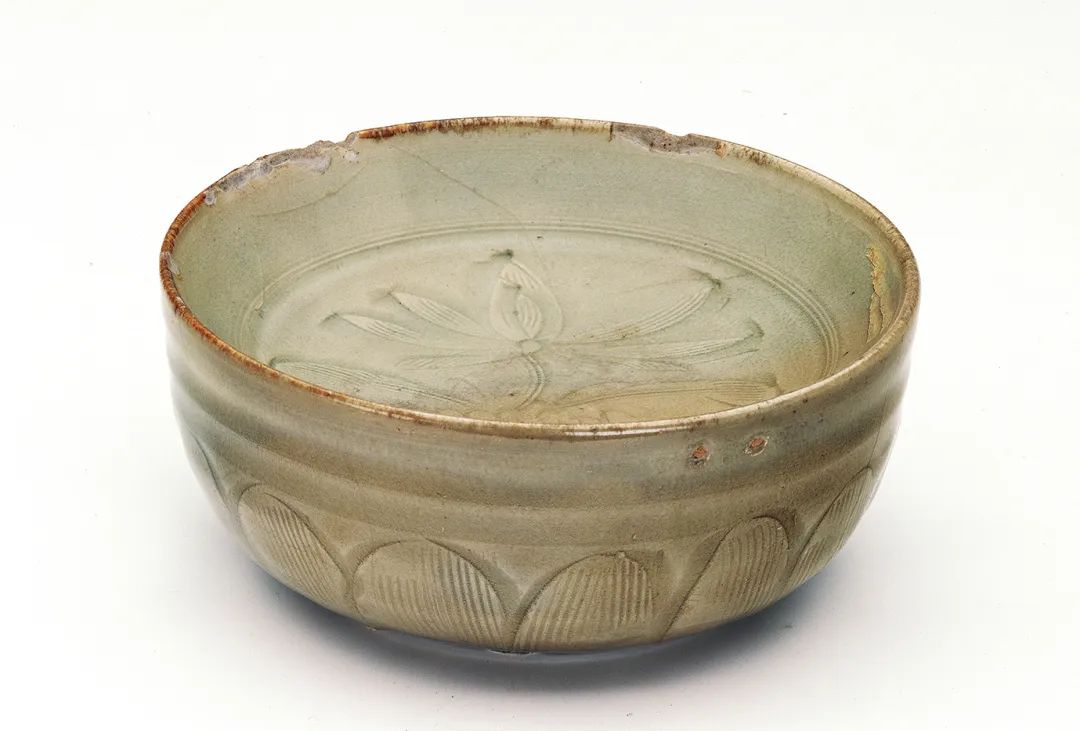
Southern Song Longquan kiln celadon lotus pattern sandwich bowl in the collection of Zhejiang Provincial Museum
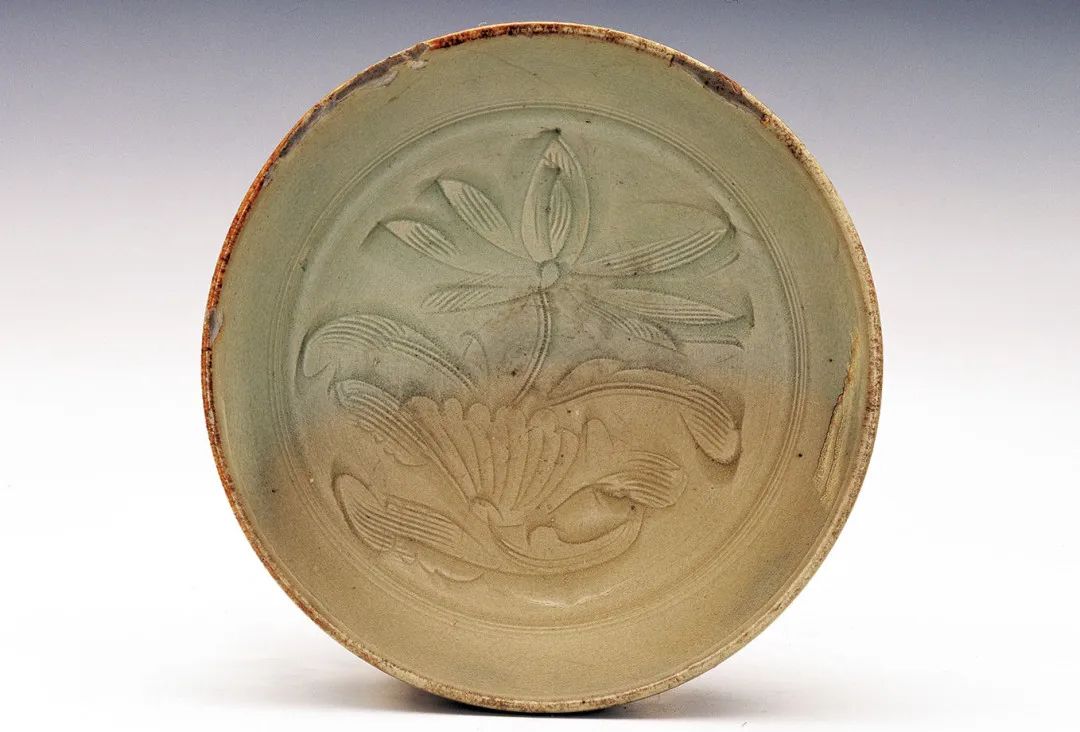
Southern Song Longquan kiln celadon lotus pattern sandwich bowl in the collection of Zhejiang Provincial Museum
The sandwich bowl is also called Kongming bowl. The surface of the bowl is in the shape of a shallow plate, and the bottom is fitted with a bowl-shaped seat with a nearly straight abdominal wall. The lotus with broken branches is carved in the heart of the pan. The outer wall of the bowl is carved with a lotus pattern. The Southern Song Dynasty was the period when Longquan kiln lotus-petal pattern bowls were mass-produced. The lotus-petal pattern bowls of this period were exquisite in workmanship, with soft lines and unique charm.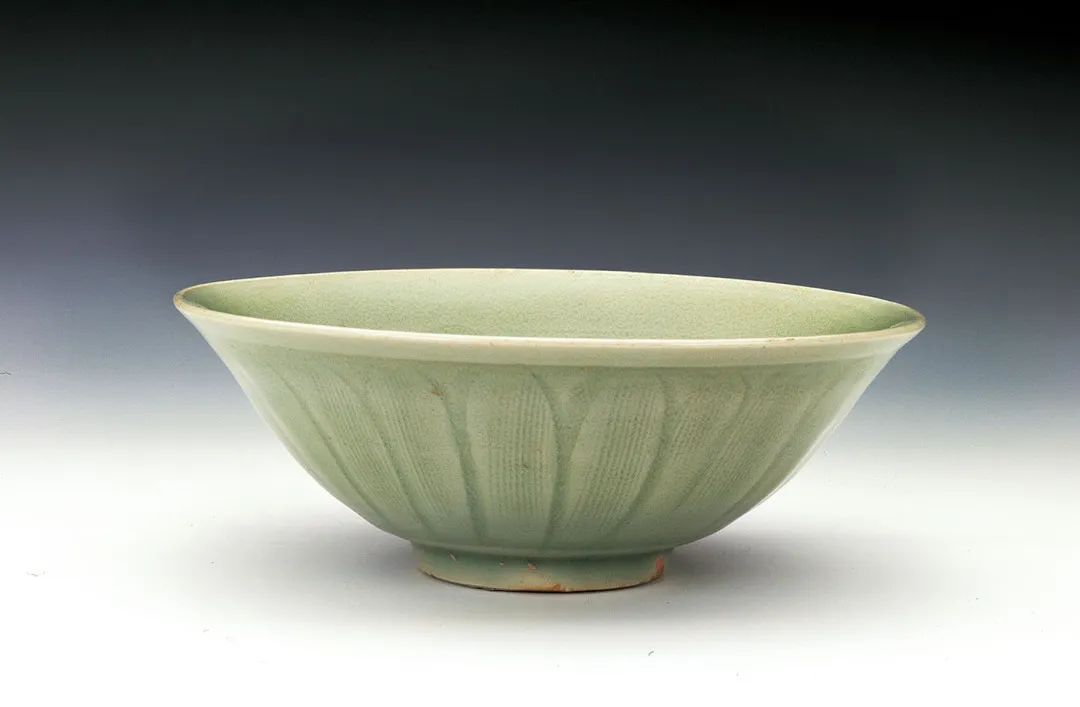
Southern Song Longquan kiln celadon bowl with lotus pattern in the collection of Zhejiang Provincial Museum

Southern Song Longquan kiln celadon bowl with lotus pattern in the collection of Zhejiang Provincial Museum
The inner wall of the bowl is carved with blooming lotus flowers and lotus leaves, and the decoration is smooth and elegant. The outer wall is engraved with a lotus pattern, and the lotus petals are filled with grate patterns. The lotus was regarded as a holy flower by Buddhism. During the Song Dynasty, when the three religions merged, the lotus that emerged from the mud and was not stained was regarded as a symbol of noble character by Confucianism. In this period, Longquan kiln products were popular with flowers carved on the inner and outer walls. And the inner wall is often decorated with broken branches and lotus.
Southern Song Longquan kiln celadon lotus pattern bird cup in the collection of Zhejiang Provincial Museum
Bird cups are also known as bird food jars. The rise of flower and bird painting in Song Dynasty, if you want to draw vivid flower and bird paintings, you need to make close observation of flowers and birds. For this reason, many flower and bird painters began to raise flowers and birds in their homes, and over time they became literati A hobby of a scholar. Under the dominance of the scholar-official culture, raising birds became a common preference of the entire society at that time.This bird food jar is in the shape of a budding lotus flower. The outer wall is decorated with stacked upside-down lotus patterns, and the powder blue glaze is applied to form the phenomenon of "ribs". Because the glaze layer is thin and flows downward, the tips of the lotus petals reveal the flint red color of the fetus, just like the petals. A little red on the tip is more vivid and vivid. It is the perfect combination of practicality and beauty.
The empty lake near the Baigong Embankment is empty in April and the lotus flowers are red
The rulers of the Yuan Dynasty abandoned the West Lake and left it behind. In the Ming Dynasty, after several repairs and expansions, it finally reproduced the scenery of "planting lotus flowers all over the lake, and willows on the banks of the embankment", "two lakes are bright, and the fragrance of lotus is ten miles away . In the late Ming Dynasty, the Qing Dynasty and the ancient traditions were prevalent in the Jiangnan area. The lotus can be admired for its leaves, flowers, and fruits. The period of appreciation is almost as long as its life cycle, and there is nothing that can be discarded. Ming people love lotus, and he wrote a lot of books to discuss the way of appreciation.
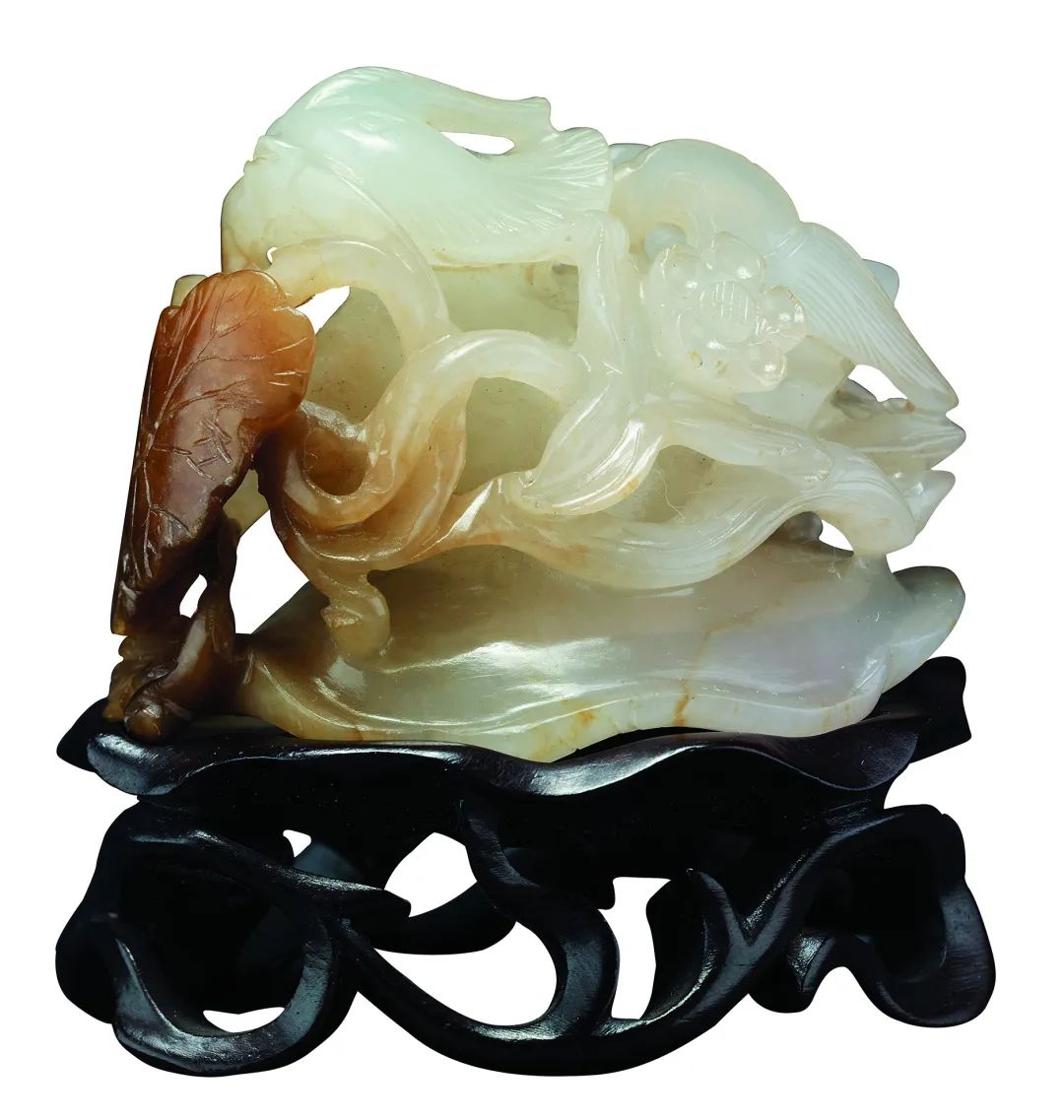
Yuanyang mandarin duck lying lotus-shaped white jade stove cover in the collection of Zhejiang Provincial Museum
White jade with yellow skin. The mandarin ducks hold their heads up and hold a lotus branch in their mouths. They lie down on the lotus leaves, among the lotus and lotus pods, with their necks narrowed. They have long crowns, phoenix eyes, and upturned wings with dense thin lines. The posture is vivid. The left and right sides of the mandarin duck are carved with blooming lotus flowers and delicate lotus pods. The lying lotus leaf is covered in shape, with undulating edges and corners, and double hook lines are cut as leaf veins.The Ming "Zunsheng Bajian" has a special record of "stove top" in the classification of jade articles. The decoration of the furnace top is all-encompassing, such as dragon pattern, panchi pattern, spring mountain and autumn water pattern, lotus leaf egret pattern, mandarin duck lying lotus pattern, etc. Different and busy.
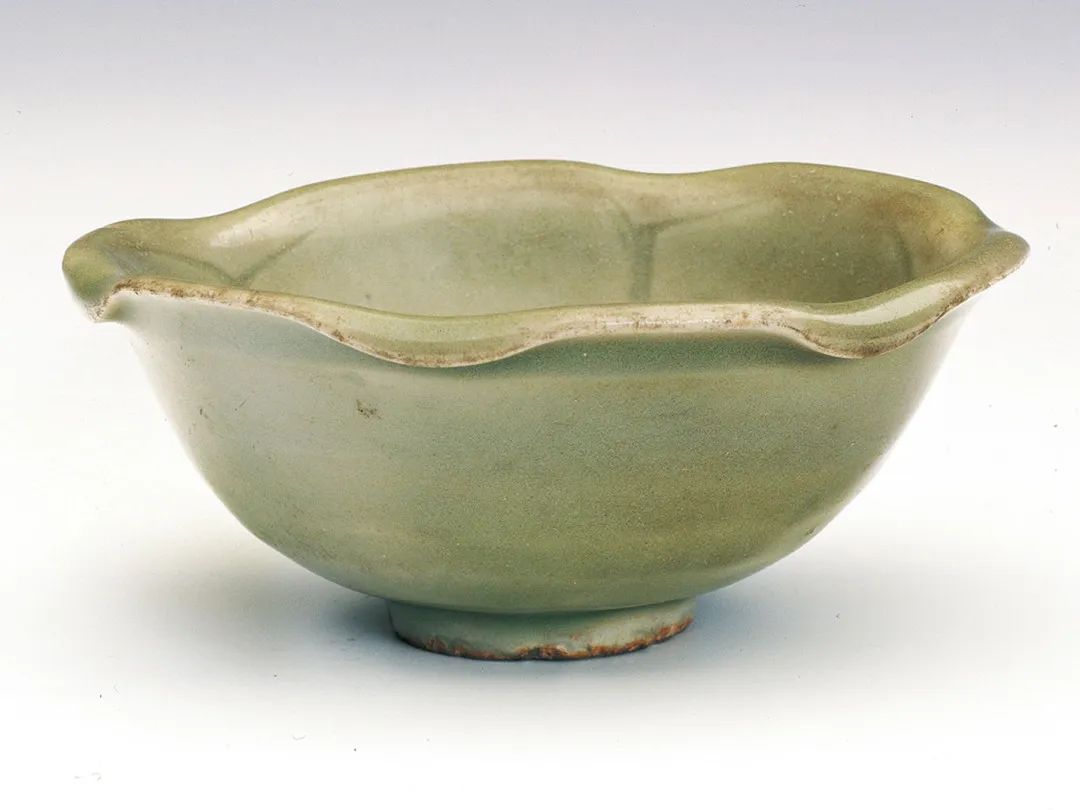
Yuan Longquan celadon bowl with lotus leaf with tortoise heart, Zhejiang Provincial Museum
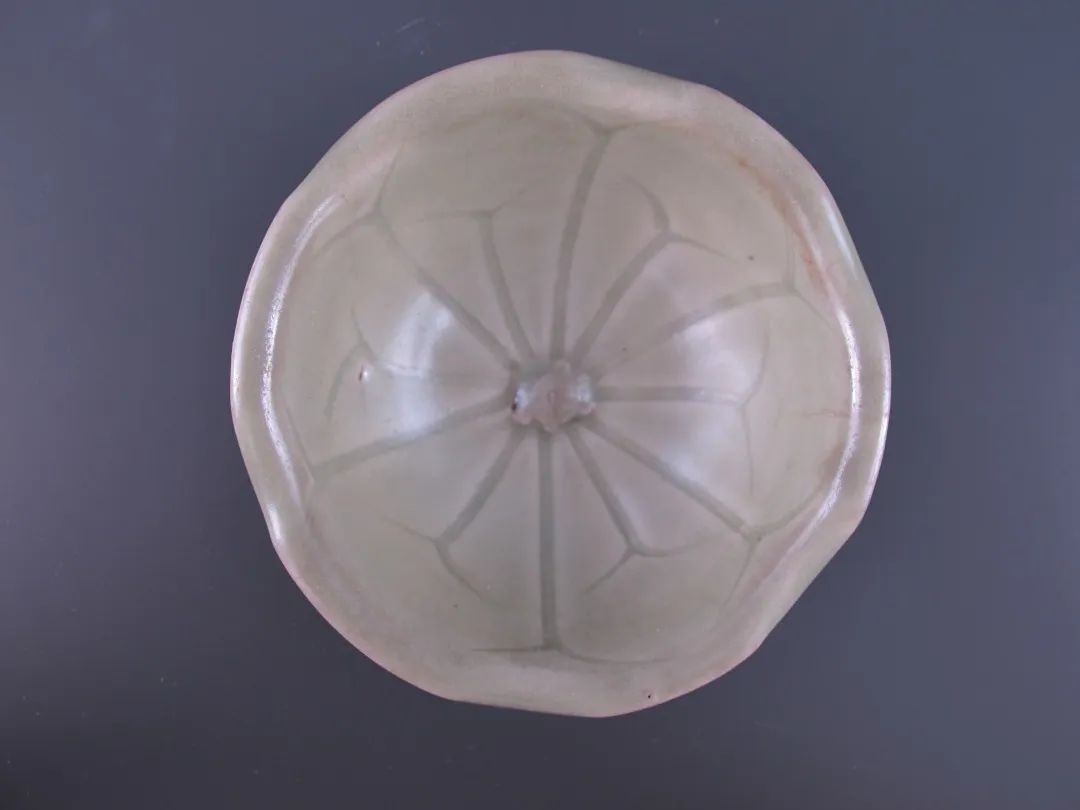
Yuan Longquan celadon bowl with lotus leaf with tortoise heart, Zhejiang Provincial Museum
The inner wall of the bowl is engraved with double-line lotus leaf veins, and a small turtle is affixed to the heart of the bowl. Turtle swimming with lotus leaves is one of the most popular themes in the Tang, Song and Yuan dynasties. It is often used as a decorative pattern on bronze mirrors, porcelain, jade and gold and silver ware. It not only implies longevity, but also people's yearning for political clarity.
Yuan Longquan celadon carved lingkou plate in the collection of Zhejiang Provincial Museum
Lingkou plate is an innovative product of Longquan kiln in Yuan Dynasty. The simple lotus flower carved on the inner bottom is a common pattern on the celadon of Longquan kiln in the Yuan Dynasty. Such utensils are often found in export porcelain.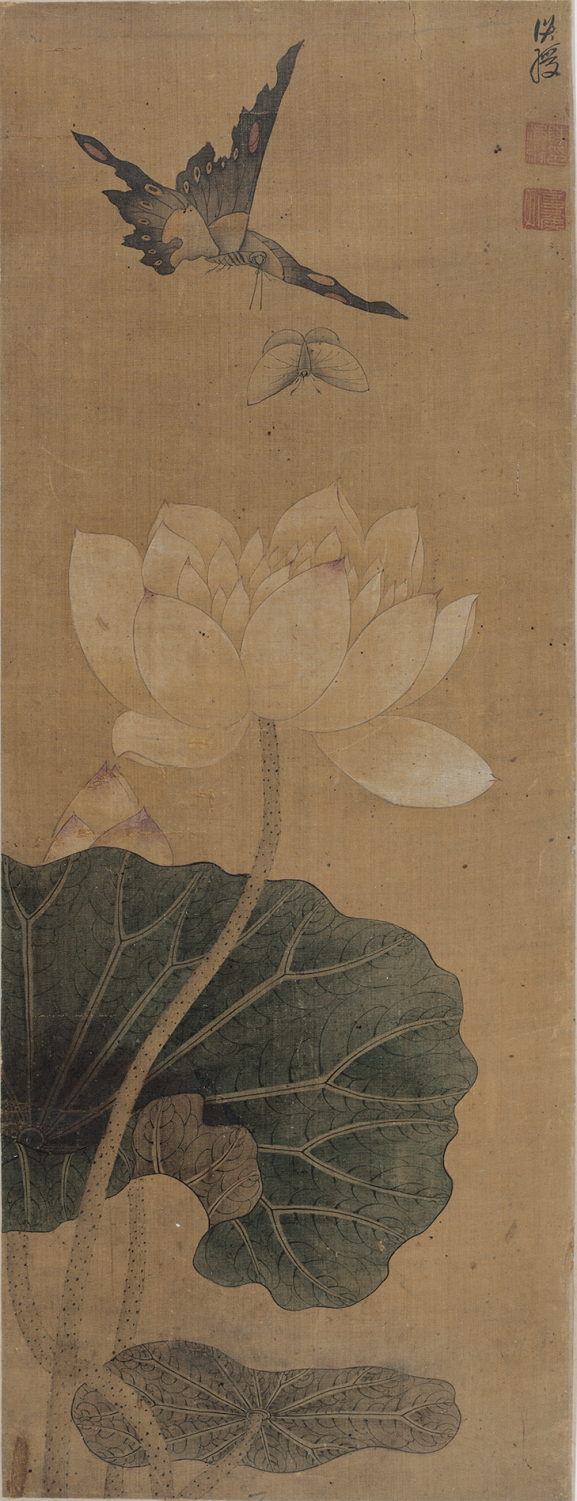
Ming Chen Hongshou Lotus Double Butterfly Scroll, Collection of the Art Museum of China Academy of Art, ink and color on silk, 63cm long, 24.5cm wide
Chen Hongshou (1599-1652), courtesy name Zhanghou, was named Lianzi in his youth, and Xu'an, nicknamed Laolian, was born in Zhuji, Zhejiang. In his early years, he studied under Liu Zongzhou and Huang Daozhou. In 1642, he went to Beijing to be a student of the Imperial Child Supervisor, taught Zhongshu Sheren, and enshrined it in the inner court. Soon he left Beijing and returned to the south. After the fall of Ming Dynasty, he became a monk at Yunmen Temple in Shaoxing. Good at painting landscapes, figures, flowers and birds, all fine. The painting has an ancient meaning, "Yeah and quiet, with an immemorial style" , which has a great influence on later generations. Author of "Bao Lun Tang Collection". This painting is a double butterfly lotus flower, which is held in the heart of a gentleman. Although plain is gorgeous, although clumsy is better than ingenuity, it is elegant, simple and fresh, calm and ethereal.
Ming Longquan celadon lotus-shaped lamp in the collection of Zhejiang Provincial Museum
The whole vessel consists of three parts, the upper part is a small cup, the outer wall is decorated with plastic lotus petals, the middle is a lotus leaf-shaped shallow plate, and the bottom is a two-layer square base, hollow and thin column, the outer wall plate and the interval between the base are decorated with plastic stickers Flower decoration. The whole vessel is complex in shape and beautiful in style.
Ming and He Er Immortal Jade Belt Buckle Collection of Hangzhou Museum
Character pattern jade belt ornament. The jade material is bluish white and pure in quality. It is made by halving a round jade material into two pieces, a hook and a buckle. Jade craftsmen use openwork and incision techniques to depict the image of the two immortals of Hehe. The boy depicted on the hooked jade piece is holding a round box, and the boy on the buckled jade piece is holding a lotus branch. Behind him is a lotus leaf and two jade pieces. A blooming lotus flower is carved at the joint. The remaining parts are openworked with twisted grass and curled clouds. The round box and the lotus are homophonic "Hehe", and the images of the two boys are the two immortals of Hehe, implying the beautiful harmony of marriage.No need to close the door to sleep by the lake
In the thirty-eighth year of Emperor Kangxi of the Qing Dynasty, the "Lotus Wind in Quyuan" was rebuilt in Yuehu Lake, which is west of Hongqiao across the Su Causeway. Emperor Kangxi changed "Quyuan Lotus Wind" to "Quyuan Wind Lotus". After Kangxi and Qianlong made their southern tours, they brought Jiangsu and Zhejiang culture to the north. The Lotus Garden in Yuanmingyuan, Quyuan Fenghe, was built according to the layout of the West Lake Quyuan Fenghe. The lotus and lotus culture in the Qing Dynasty went further in the secular direction. The auspicious graphics and words related to lotus were deeply rooted in the hearts of the people. A popular cultural symbol.

Qing Dynasty Emperor Gao's Ten Scenes of the West Lake Album Collection of Zhejiang Provincial Museum, color on paper, vertical 16.3 cm, horizontal 32.5 cm
Dong Gao (1740-1818), courtesy name Yalun, no. The eldest son of Dong Bangda, he is good at calligraphy and painting. The cover of this book is signed "Zaoyao Lake Mountain", and the ten scenes of the West Lake are written inside. This page is titled "Wind Lotus in Quyuan", with the title of the imperial poem: "When guests come to the spring, the lotus has not bloomed, and the flowers are difficult to explore and there are many interesting things. Smelling the fragrance of Daoming Lake is ten miles away, and the wind is like listening to the song of picking lotus."
Qing Renyi Lotus Double Swallow Scroll, Collection of Zhejiang Provincial Museum, ink and color on paper, vertical 180.1 cm, horizontal 44.6 cm
Ren Yi (1840-1896), originally named Run, styled Ziyuan, No. Xiaolou, changed his name to Yi, styled Bonian, with the character Xing, No. Living in Shanghai, he will end his career as a painter. Painting subjects are wide, portraits, flowers, birds and landscapes are all incomparable; techniques are comprehensive, and emphasis is placed on sketching. In his paintings, the lotus and double swallows are more common. This lotus flower is outlined and filled with powder, hidden in the lotus leaf, the lotus leaf flutters in the wind, the reed grass is densely packed in the lotus pond, and two swallows slant the water surface.It was once collected by Qianjingtang.

Qingyuji 1st Road Qinglian Scroll, Collection of Zhejiang Provincial Museum
Yu Ji (1738-1823), courtesy name Rongshang, numbered Qiushi, was a native of Renhe (now Hangzhou). After the official to attend a bachelor's degree, after his return, he entertained himself with literature and art. Sexual alcohol is high, and it is especially good to lead the way. The work of landscape, the pen is elegant and elegant, with the "mountain light in the palm of the hand, the cloud is full of clothes" ; the good lady, the wind spirit is quiet. This painting of egret and green lotus, borrowed from homophonic meaning, is signed "Yichou (1805) Xia Fu Chen Hongshou".It was once collected by Qianjingtang.
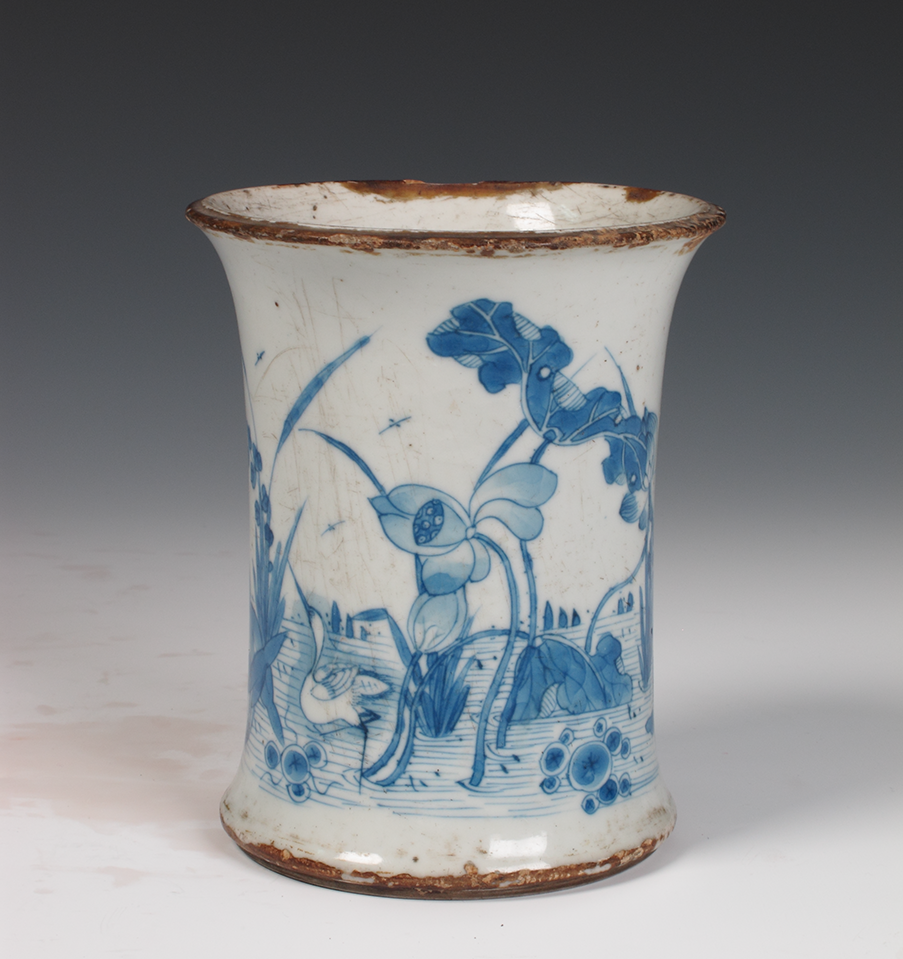
Qing Kangxi blue-and-white lotus pond pen holder in the collection of Zhejiang Provincial Museum
White glaze is applied inside and outside the pen holder, and the glaze color is clear. The outer wall is painted with a heron and a lotus pond in blue and white, which means "connecting branches all the way". This ornamentation takes the homophony of heron and road, lotus and lian, indicating that the imperial examination is going smoothly. In ancient times, scholars especially liked the decoration of this theme in order to seek fame and fame.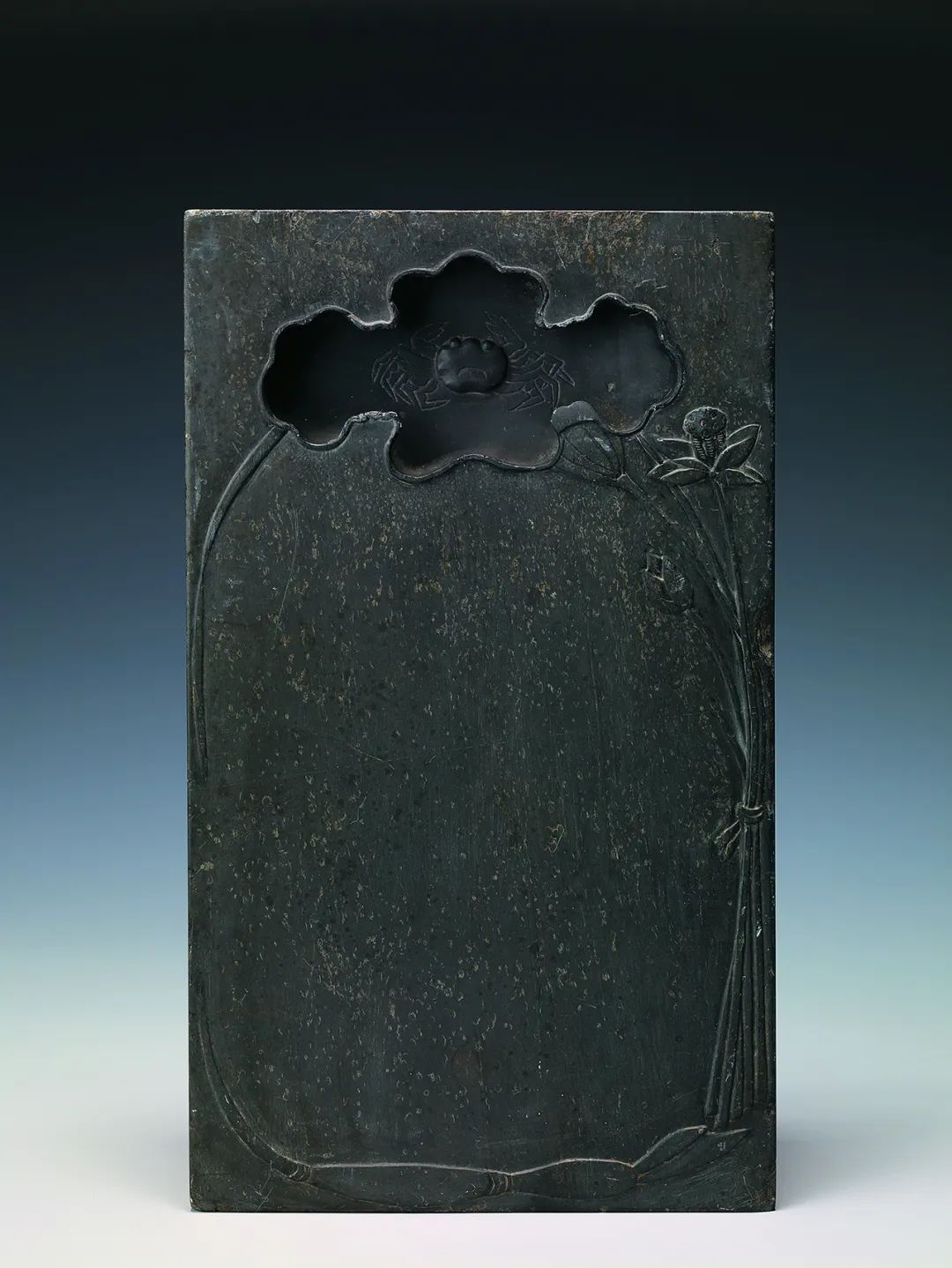
Qing Interesting Caviar Pattern She Inkstone in the Lotus Pond in Qing Dynasty Collection of Zhejiang Provincial Museum
She inkstone with caviar pattern is one of the famous She inkstones. It is named after the dense black dots evenly distributed in the inkstone, shaped like roe (fish eggs). The stone is green and delicate, and can be breathed into mist. A lotus pond is carved on the surface of the inkstone, lotus swaying, and lotus leaves are imitated by the inkstone pond. Literati elegant, all in it.
Qing Yongzheng pastel lotus and water grass plate collection of Zhejiang Provincial Museum
Pastel, also known as "foreign color", is fired on the basis of enamel color porcelain and belongs to overglaze color. Yongzheng pastels are mostly painted directly on the white glaze surface. The body is fine white and the glaze is lustrous. The shape of the ware is mainly made of daily-use porcelain, as well as furniture such as study utensils. The inner bottom of the plate has a pastel lotus and lotus leaf and water grass pattern, and the glaze is warm and smooth, showing a sense of elegance and softness. Outsole "Elegant Antique" blue and white double circle double line seal script.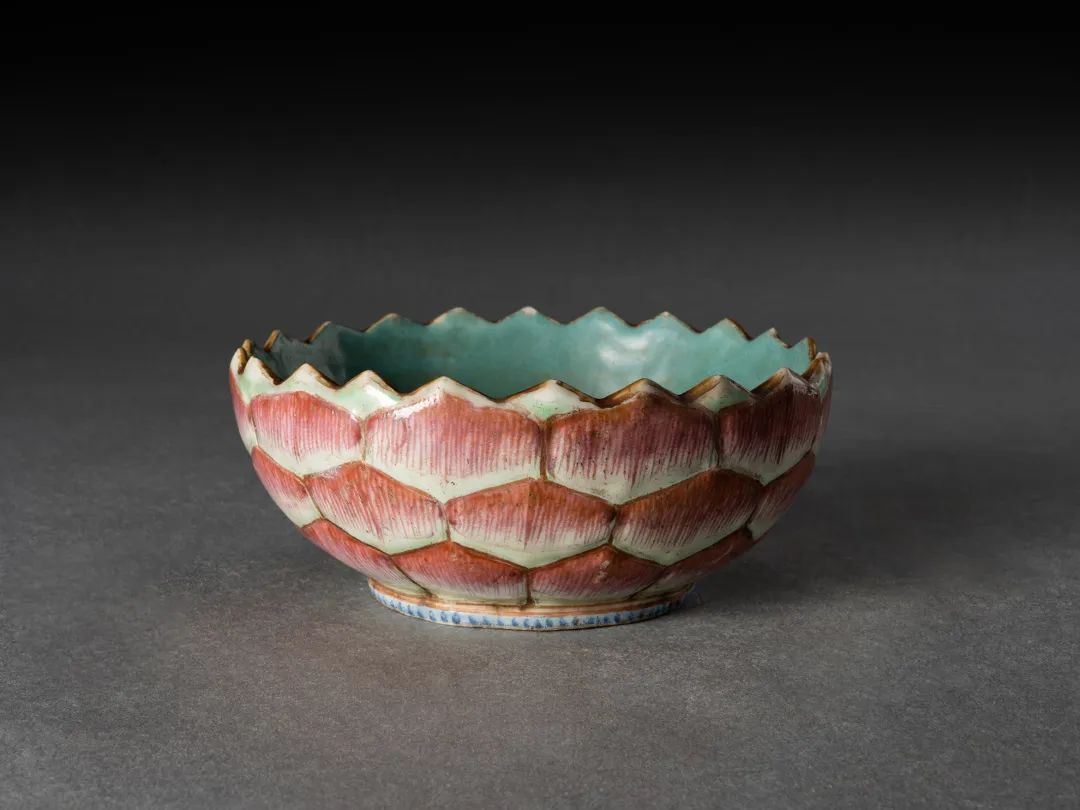
Qing Tongzhi pink lotus petal-shaped bowl in the collection of Zhenjiang Museum
The bowl is a three-dimensional shape with multiple lotus petals. The outer abdomen is covered with light green glaze, and the inner wall and outer bottom of the bowl are turquoise green glaze. Each layer of lotus petals is painted with rouge red color and line-drawn flower veins, and the six-character seal script "Da Qing Tongzhi Year System" is written in the red color box at the bottom.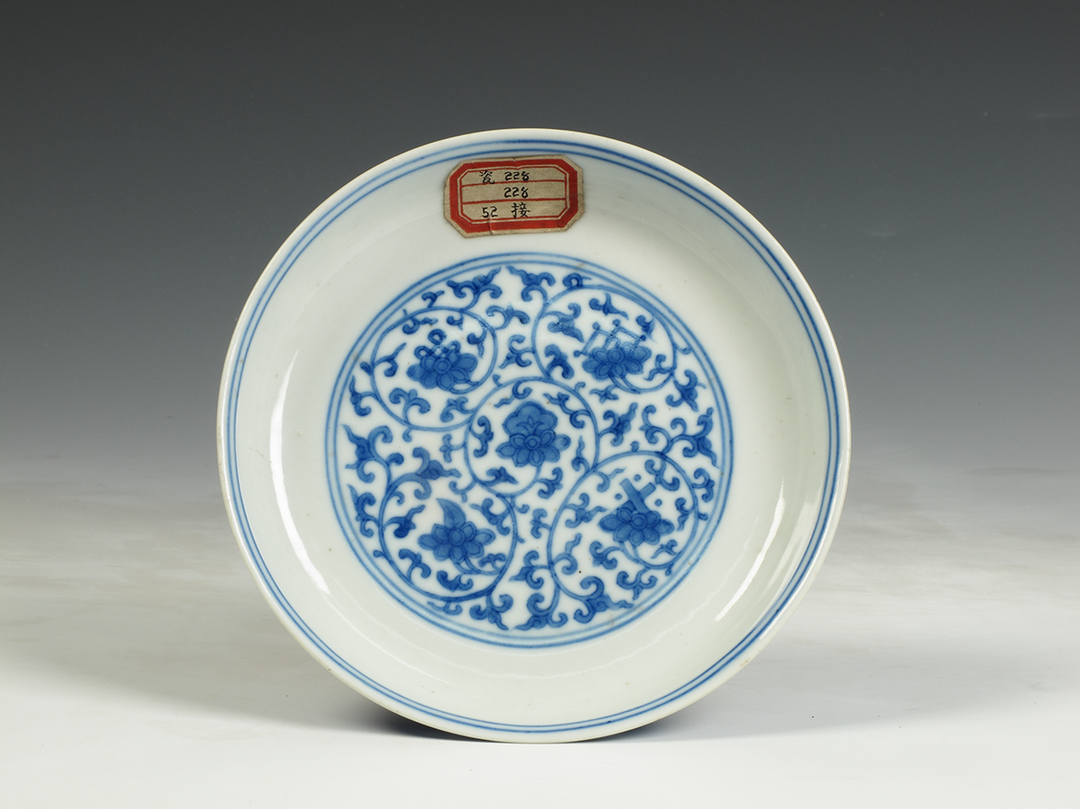
Qing Dynasty Yongzheng "Qingyintang System" blue-and-white eight-treasure plate with entwined branches and lotus support, Zhejiang Provincial Museum
The motif of this piece is a typical pattern of "Eight Treasures of the Lotus Holder", and both the inner bottom and outer wall are painted. The inner bottom is painted with Fangsheng, Panchang, Autumn leaves, clapper, etc. The outer wall is painted with silver ingots, fruits, copper coins, fire beads, double horns, cornucopia, Ruyi, clapper, and there are double circle string patterns on the upper and lower sides. "Qingyintang system" double-line regular script on the outsole.The lotus leaves are like clouds, and the boat is swaying into Xiling
In the late Qing Dynasty, when foreign powers invaded, the traditional gardens of the West Lake were also devastated, and the lotus flowers in the West Lake were also greatly affected. In the 1950s, the West Lake dredging project started. Since the 1980s, the West Lake has begun to plant lotus on a large scale in a planned way. Today, there are more than 200 varieties of lotus in Fengheli in Quyuan. The ancients sang the lotus in the way of poems and songs, and today people love the lotus in a fashionable and creative way. Lianhe brings inspiration and innovation to people because of its elegant appearance and meaning of peace. In recent years, ancient lotus seeds unearthed from the strata of the Song Dynasty have been cultivated and awakened and bloomed everywhere. The lotus has become the seed of friendship and the bridge between ancient and modern.
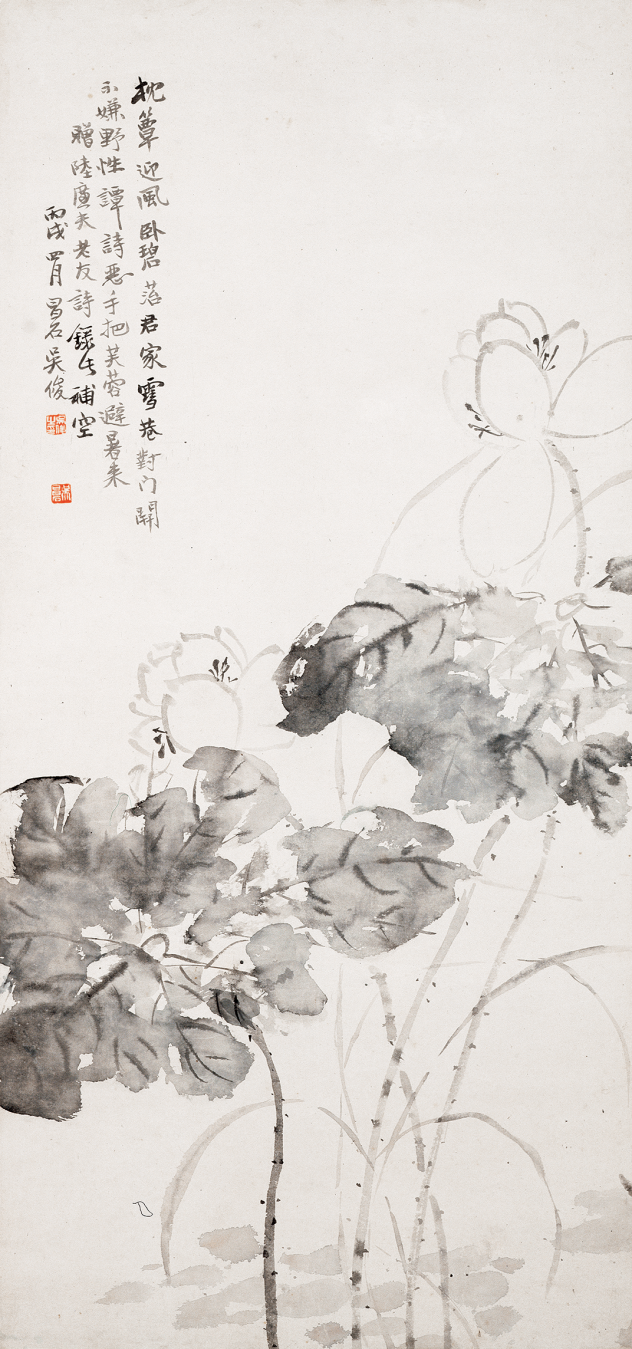
Wu Changshuo, ink lotus scroll, collection of Zhejiang Provincial Museum, ink pen on paper, 98.5 cm long and 46.1 cm wide
Wu Changshuo (1844-1927), originally named Jun, also known as Junqing, the word Changshuo, and the names of Cangshi, Cangshi, and many aliases, there are Cangshuo, Lao Cang, Lao Fou, Ku Tie, Da Deaf, Fou Taoist, Venerable Stone, etc. Zhangwu village (now in Anji, Huzhou) people. The first president of Xiling Seal Society. This ink lotus was painted in 1886, when Wu Changshuo was forty-three years old.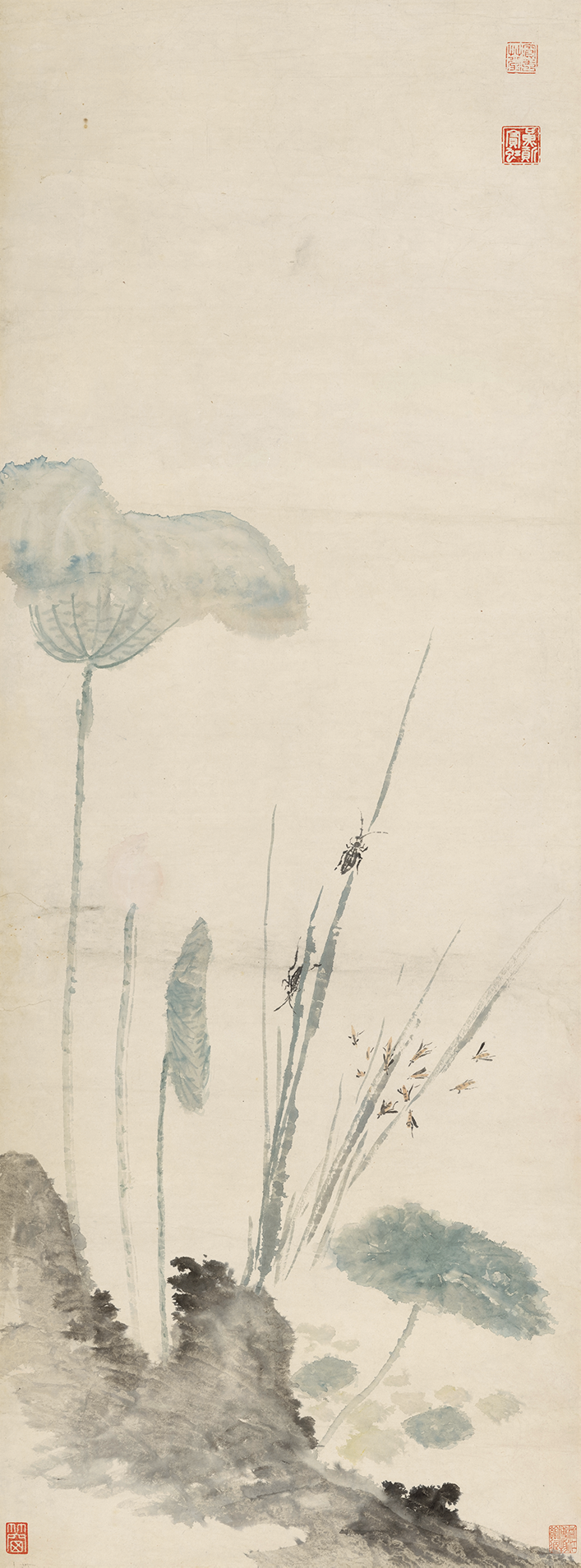
Huang Binhong Lotus Pond Autumn Interesting Scroll, Collection of Zhejiang Provincial Museum, ink and color on paper, vertical 106.6 cm, horizontal 39.9 cm
Huang Binhong (1865-1955), formerly known as Zhi, with the word Pucun, and other names such as Yuxiang, Honglu, Hongruo, Hongsou, etc., changed his name to Binhong in the middle age, and used the number line. A native of Shexian County, Anhui Province, he was born in Jinhua, Zhejiang Province. Famous for landscapes, he is also good at flowers and birds, and he values the beauty of nature. There are "Ancient Paintings Micro" and so on. Inscribed on this axis is a clump of reeds, a few seedlings of small lotus, a beetle, and a mass of fleas and mosquitoes. It is supported by spirit and spirit, pure and natural, without ingenuity, and under innocence, a clear light.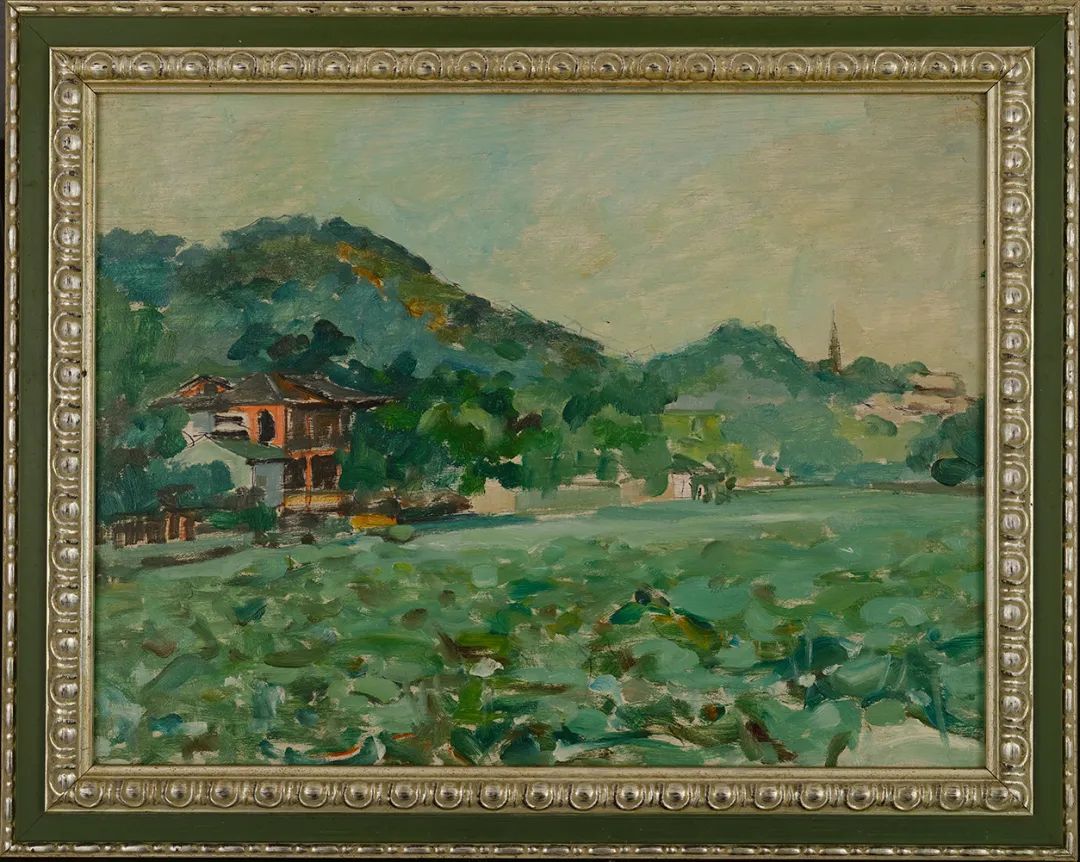
Chang Shuhong Lotus Pond Wangbaochu Pagoda, Zhejiang Provincial Museum Collection, oil painting on wood panel, 40.6 cm in length and 53.5 cm in width
Chang Shuhong (1904-1994), born in Hangzhou County, Zhejiang Province, with the full surname Yiergen Gioruo, is a Manchurian. In 1923, he graduated from the Dyeing and Weaving Department of Zhejiang Provincial Class A Industrial School and stayed there. In 1927, he went to France to study oil painting. After returning to China, he taught at the Peiping Art College and the National Art College. He went to Dunhuang in 1943, devoted his life to the research and protection of Dunhuang art, and was called "the patron saint of Dunhuang". This close-up view is the lotus bank of Lixi Lake, and the distant view is Gem Mountain. It is a sketch of the West Lake in his later years.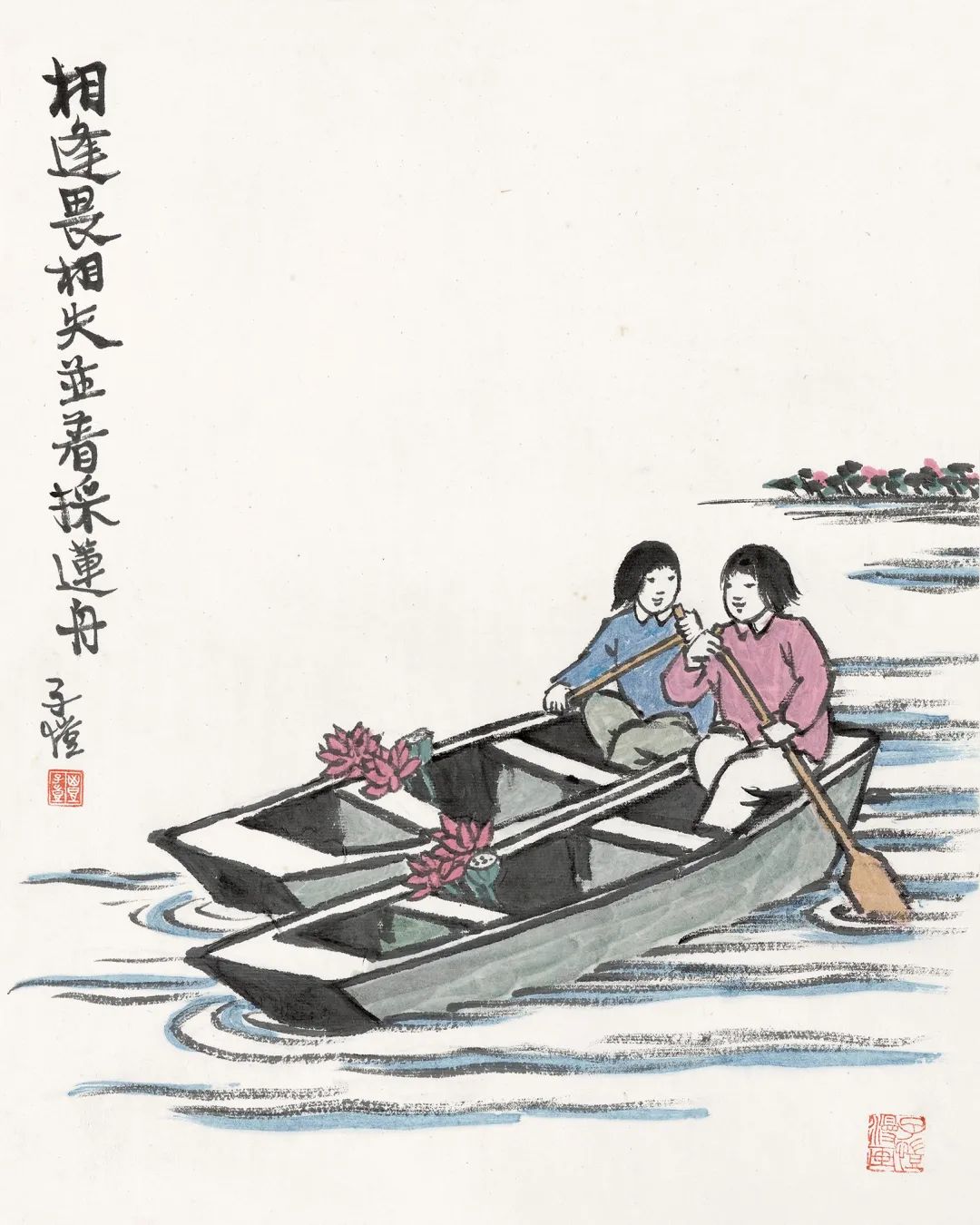
Feng Zikai co-authored the lotus-picking boat page, collected by Zhejiang Provincial Museum, ink and color on paper, 34.5 cm long and 27.5 cm wide
Feng Zikai (1898-1975), formerly known as Fengrun, nicknamed Ziqi, later changed to Zikai, nicknamed Yuanyuantang, was born in Shimen (now Tongxiang, Zhejiang), and studied under Li Shutong and Xia Chengzun. He has outstanding achievements in comics, calligraphy, translation and other aspects, and has published a lot of books, paintings, prose works, art theory and music theory. In the painting, two women, one with a paddle, are walking on the water side by side, and the lotus flowers are carrying the boat, as if they are going to pick lotus together. The title of the painting is "Fear of losing each other when meeting each other, and wearing a lotus-picking boat" .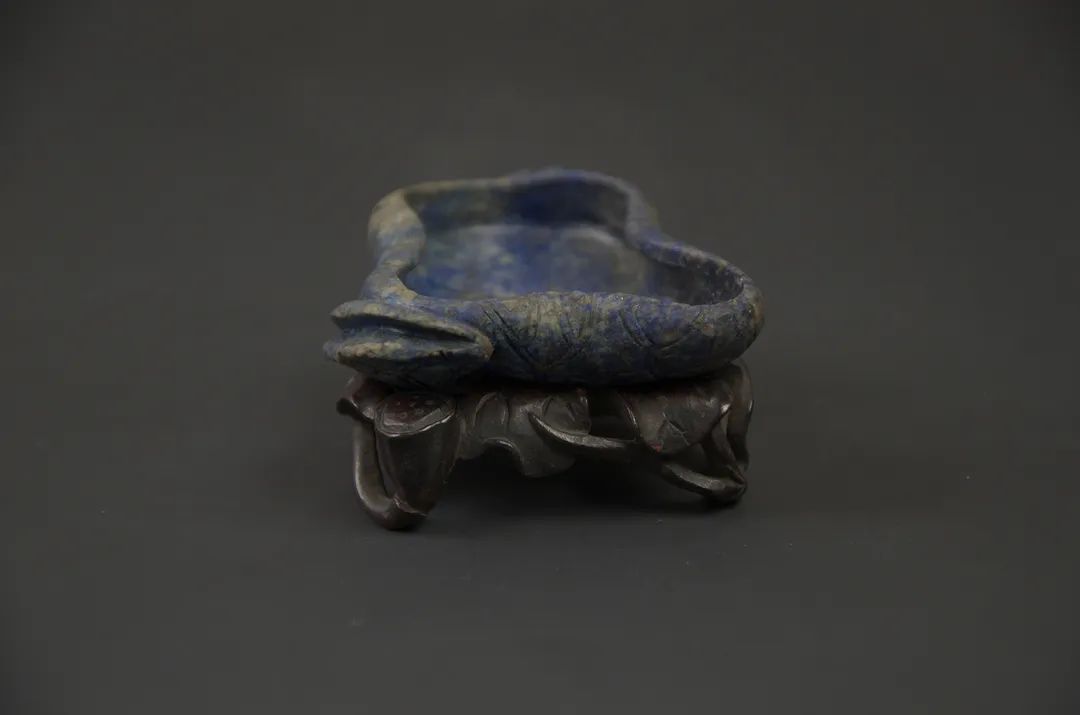
Late Qing Dynasty and the Republic of China Stone Carving Lotus Leaf Water Bowl Collection of Zhejiang Provincial Museum

Republic of China brown lacquer painted gold happy eyebrow pattern lotus leaf scroll plate collection of Zhejiang Provincial Museum
In the hot summer, the lotus pond cools off the heat, the front is bright and the wind is full of fragrance.Under the lotus leaves in the fields, mandarin ducks swim and fish play; among the lotus flowers, hummingbirds and dragonflies perch. In the rippling blue waves, you can enjoy the agility of the new lotus in the fish show, and the tranquility of enjoying the fragrance of the lotus in the wind.
In the hearts of traditional literati, plants and trees are all about love. Hekai, Hesheng and Heluo carry noble quality and poetic life. Thousands of years ago, Zhou Bangyan, a native of Qiantang in the capital, wrote the graceful appearance of the lotus pond in the south of the Yangtze River with "the water surface is clear and round, and the lotus lifts one by one". The earnestness of the homeland and the pursuit of a spiritual home.
The mountains and rivers know the summer, and the scorching old flowers;
The lotus is ten miles away, and the moon is full of clothes.
Fu Chun opened Shang Yingying...
The exhibition will last until September 7.